The Enthusiastic Gardener
This article covers an innocuous injury leading to a severe infection in which a bug got out of hand. Usually, skin wounds don’t cause more than a minor inconvenience. In Wills’s case, this was not to be the case. Wills loved to busy himself in the garden and could be seen on his powerful sit-on mower during warmer months. He agreed to an interview for ConsultingFootPain to talk about a wound that developed rapidly on the back of his foot.
First Signs
First, he noticed a crack in his heel after a day’s gardening. He had been wearing his gardening shoes and usual shoes and clothes. “I just thought it was a chapped heel which had happened to me before.” A day later, he noticed a red patch on his foot. “That’s all I thought about it. Later it went septic.” Wills said that all he could think was, “a bug had got into it!”
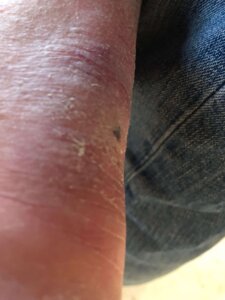
Area (dark) wound at the back of the heel
The area affected was just above the heel bone (calcaneus). Putting weight on his foot became a problem, and a trip to the doctors lead to antibiotics. The mother of all bugs had infected his foot. Oblivious to the consequences of an infection and perhaps not realising its creeping effect that can lead to loss of a limb or life, Wills soldiered on and waited until the wound “literally burst. Blood and pus just started oozing out… quite thick stuff.” Asked how he felt about the change in the foot, he said, “I thought good news. This meant hopefully whatever the infection is that’s in my ankle or foot is getting away, is getting out.” Zandra, Wills’ wife, dialled NHS 111, a telephone triage service. After several calls, Wills’s priority went through to the next stage, his wife explained. After this, a doctor rang back. In the end, they had an appointment to go to the County Hospital late afternoon. A ‘locum‘ doctor saw Wills to arrange his admission. All of this had been arranged through NHS 111.
Clinical comment
The point above the tendon-Achilles is exposed in footwear. The skin is creased to allow for the up and down movements at the ankle. The depth of skin is shallow, and the underlying this skin is the big tendon complex. Wounds in this area can lead to deeper infection because the blood supply is not as well established. The mythical story of Achilles comes to mind, which reminds us of the vulnerability of this part of the foot-ankle. Blister discharge may well relieve the pressure if the area hurts. The blood is associated with damaged capillaries, often due to bacteria. The lower half of the wound is more worrying as the skin caused by blister sloughing means the area has no skin cover. Slough or sliding of the skin means it is no longer viable and will not heal. Debridement can be achieved in the clinic at this point. Will’s had already lost the first battle, and his inability to heal from a small wound.
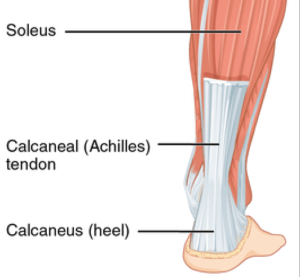
https://commons.wikimedia.org/w/index.php?curid=64291156
Optimism
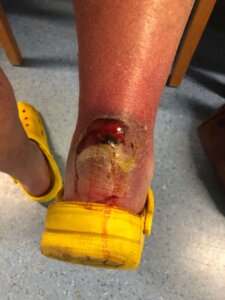
the location is easier to appreciate
I was interested in how Wills responded to all this emergency activity. So I asked him, “Things weren’t looking good for you, the doctors were quite worried, but you say that you’re an optimist. But there was the possibility that you could have lost your leg at this point. Somebody could have told you that you could die through septicaemia. So what was your thought process?”
He responded that he was not advised of death or losing his limb.“I didn’t think of septicaemia and dying, to be honest. That didn’t really cross my mind. So far as anything else is concerned, it seemed to be progressing quite quickly, the disease or the infection, and so that was a concern if they couldn’t get it better but there’s not a lot more I could do about it at the time.”

The NHS 111 number dials into a bank usually handled by qualified nurses. Medically unqualified administration staff can act as first-line responders in order to activate a series of actions. The system was introduced in the UK in 2014 after a trial run the year before and replaced NHS Direct.
A bad bug
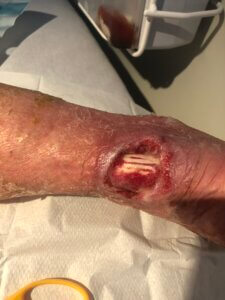 Wills had seen a few medical staff and eventually came under the orthopaedic team the day after his admission. A Covid test provided was negative and cleared him for surgical cleaning of the wound called debridement. He was now on intravenous antibiotics. IV antibiotics provide a strong concentration of antibacterial medication, which provides better absorption and penetration into tissues than tablets would if given by mouth. The antibiotics are usually powerful and often more specific for the type of bugs found. The bug that had infected Wills was Pseudomonas. This is particularly nasty in human tissue. Pseudomonas is normally found in soil and water, but in anyone, with low immunity, this bacterium can create lethal consequences. The figure shows the tendo-Achilles exposed after the County Hospital had cleaned the dead material away.
Wills had seen a few medical staff and eventually came under the orthopaedic team the day after his admission. A Covid test provided was negative and cleared him for surgical cleaning of the wound called debridement. He was now on intravenous antibiotics. IV antibiotics provide a strong concentration of antibacterial medication, which provides better absorption and penetration into tissues than tablets would if given by mouth. The antibiotics are usually powerful and often more specific for the type of bugs found. The bug that had infected Wills was Pseudomonas. This is particularly nasty in human tissue. Pseudomonas is normally found in soil and water, but in anyone, with low immunity, this bacterium can create lethal consequences. The figure shows the tendo-Achilles exposed after the County Hospital had cleaned the dead material away.
The first surgery
Wills picks the story up after his first surgery. Like the tide receding, he could not see what was left. “Because the hole was so deep, having cleared it out, I would probably need a flap. And that whilst the County Hospital did do some skin grafting; they weren’t really keen to do it on my wound give its severity. I’d have to go to another hospital.” He describes the appearance of his wound – after more operations, “there was a hole the size of a ping pong ball and a completely bare Achilles’ tendon.”
Set Backs
Most people know about plastic surgery from cosmetic work. The clever skill behind this surgical specialty is the use of skin to cover wounds and build new areas of the body. Burns management is one of the plastic surgeons’ largest areas of work. Wills was in for Christmas and away from his family. The virus imposed, at the time (2020) placed visiting limitations on family and friends. For Zandra, this was a stressful period away from her husband and worrying about his eventual outcome. Meanwhile, Wills was moved on to different wards. He waited for a bed in the specialist hospital, a distance of 40-miles away. He was re-tested for Covid and, on this occasion, found to be positive. This was where matters became tricky as the hospital tried to persuade Zandra to return Wills back home.
 England saw its third lockdown in January 2021. Zandra was not able to manage a husband who, by self-admission, was not patient to sit around idly. One realises the collateral effects of disease and injury is not just for the patient but for the family as well. The hospital suggested Zandra might go to a hotel, which of course, was rejected with equal verve. A hostel was suggested. The tirade continued to persuade Wills to leave the hospital.
England saw its third lockdown in January 2021. Zandra was not able to manage a husband who, by self-admission, was not patient to sit around idly. One realises the collateral effects of disease and injury is not just for the patient but for the family as well. The hospital suggested Zandra might go to a hotel, which of course, was rejected with equal verve. A hostel was suggested. The tirade continued to persuade Wills to leave the hospital.
“I think I’d been assaulted three times by the request. Eventually, I think they were going to get me to someplace in a nearby town, and then out of the blue, they said, “Now a bed’s become available.” And I said, “What, in the nearby town?” The nurse said, “No, no, the specialist hospital.’ So that’s when we went off.”
Plastic surgery & another hospital
Wills was seen the next day, having been conveyed in a private ambulance the night before. This was all done under the NHS. “I didn’t meet the surgeon before the operation, although I had met one or two of his team beforehand. Initially, I thought that the person who was doing the work had come to see me, but later I find out when I go back for aftercare who the surgeon was.
Wills had had three general anaesthetics before they gave him an epidural anaesthetic. This is given in the lower back and makes the lower limb very numb. In this way, he could have surgery without any pain and remain awake.
Clinical Comment – skin grafting
At one point, Wills thought all was healing well. However, a skin graft was necessary. The body can heal remarkable well and replace damage but with consequences. Replacement tissue is like the body’s glue and made from collagen ( a body protein). This forms the basis of scar tissue. Scar tissue tethers skin movement, and because the wound is associated with another collagen structure – the big ankle tendon (Achilles), an open wound could lead to further disability and a permanent limb. This would affect the ankle movement in the long term. A plastic surgical procedure uses skin from the front of the thigh. This is used to cover the hole left by the cleaned out tissue.
After Effects & conclusion
 Wills had by now been in hospital over Christmas, and the end of January 2021 came into sight. Wills was told his foot would take 18 months to heal and that it would change colour throughout this process. He was finally discharged and could come home. I asked him what the post-operative care had been, and how he felt about the care after discharge from the hospital.
Wills had by now been in hospital over Christmas, and the end of January 2021 came into sight. Wills was told his foot would take 18 months to heal and that it would change colour throughout this process. He was finally discharged and could come home. I asked him what the post-operative care had been, and how he felt about the care after discharge from the hospital.
“It’s been brilliant. Since leaving hospital, I was booked an appointment to go every week so that they could obviously see how the wound was progressing and how it was healing. And then the first week, they took the staples out because my surgeon quite likes to be quite handy with his staples, and that was not very pleasant. But after that, they could see it was healing up.”
Zandra pointed out that Wills had had a cast that ended up being on for a week longer than he would have liked. When the cast came off, Wills was provided with plenty of dressings which she was shown how to use so he could come home. Casts are used to immobilise joint movement, and this allows healing and prevents damage from unexpected pressures while still allowing mobility. Mobilising patients retain healthier muscles and, above all, stop blood clots. Wills had been having injections to prevent this from happening all the time he could not move. No physiotherapy was required, and Wills now had a good range of movement in his ankle. I asked him of the long term expectations,
“are you optimistic that you’ll be getting back to everything you previously did?” He looked at me with half a smile and said, “I’d be flabbergasted if I wasn’t optimistic. I’m almost back to what I was doing. Seriously, I’m not that… So I’m not optimistic. I’m back!” Adding a grin to the tale.
Wills and Zandra view success behind this harrowing tale with the knowledge they and the family went through a period of immense worry. They speak highly of all those who treated them during the 4-month process. His skin graft donor site and the site of this nasty wound have recovered without numbness. Zandra can now put the first memories of waiting in the car at the first hospital for news behind her. She had spent five hours sitting in a car park and was only able to enter the hospital to go to the loo. Zandra is a realist and knows her husband well and nonchalantly says, “I probably worry more than he does. Yes, I think so.” Wills wrote up his account for his local resident’s magazine called ‘The Rousdoner’. His sense of humour and optimism shines through and gives an insight into this thoroughly nice, unassuming man who would help anyone locally. Here are a few of his apposite comments:
“Despite the chefs best efforts (Raymond LeBlanc would not have helped), it was difficult to summon up any enthusiasm for mealtimes.”
“Being bed-bound, I was able to read various books. For “Cold War” aficionados, I thoroughly recommend “1983. The World on the Brink”, by a local author which sets out how lucky we are to be here and alive in 2021.”
“My liver thought it was on holiday. A dry Christmas and New Year was not what I had planned, but no doubt I am the better for it.”
At the time of this interview (23rd March 2021), Wills and Zandra still have a little Christmas cheer with lights on the tree. Wills says, “A discussion is yet to be held over when and if they will be taken down. I am already planning for Christmas 2021.” He ends his article in The Rousdoner with a comment, “And as to the moral of this story, I shall leave that to you!”

Will’s let me take a final picture of his foot as we trickled into the month of July. Wondering why it had not completely healed, he leaned over his wall to talk to me, his neighbour, only to explain he had just found a staple that decided to cause annoyance. Once removed all looked fine. Given all his problems I would say Wills is one lucky man. And the Christmas tree has now come down.
Moral of the tale
Perhaps I can fill with a moral to the tale from the clinical perspective. There is, of course, a moral for why tell Wills’s story? The story came good, as one might say, but could it have been avoided? We all injure ourselves from time to time, and safety at home is as important as work. Innocuous wounds can lead to fatal consequences even in healthy individuals. It is important to realise the garden is full of material that can find its way through the skin. A crack or scuff is all it takes when conditions are right. The skin is a wonderful defensive mechanism when intact. Footwear with thick soles and higher protection around the ankle is recommended for manual work outside. The first world war taught us much about mud and dampness in terms of foot problems. Necrotising fasciitis may not be easy to pronounce, but it certainly accounts for many deaths arising within 48 hours. Wills’s antibiotics certainly helped but would never have been enough to prevent serious deterioration in health without hospital care.
Special cases
All diabetic patients are told to examine their feet daily for injury. We must all do this and deal with wounds early. Antiseptics still are important and can avert deeper infection along with washing. However, the wound Wills presented with looked innocuous and yet the tinge of dark red hue is a sign of damage. Even in the case of mild breaks in the skin, wash the wound thoroughly, apply an antiseptic cream and monitor carefully for the first 48 hours. The fact that his wound burst was good because the tendon (Achilles) would have allowed the infection to track straight up his leg through the sheets that separate muscle called fascia. The tendon has a poor blood supply, and the fascia has none. Blood is required to supply healthy healing and bring white blood cells to the playground to fight early bacteria.
Perhaps Wills, like a number of people, do take the view that everything can be fixed and certainly place faith in the healthcare system. Indeed this is probably true, but the moral is we all have to be aware of the dangers – so if you go down to your garden today, make sure there is no surprise!
My gratitude to Wills and Zandra for sharing their story openly and providing photos of the sequential events
Thanks for reading ‘the foot bug that got out of hand’ by David R Tollafield

Published by Busypencilcase Reflective Communications. Est 2015
6 August 2021


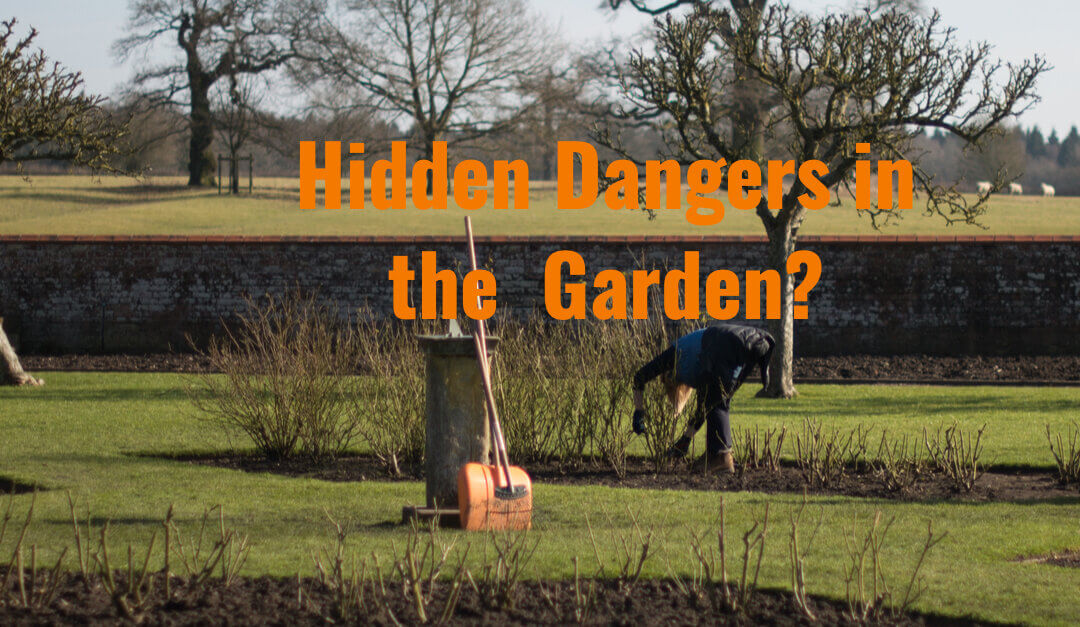
Recent Comments